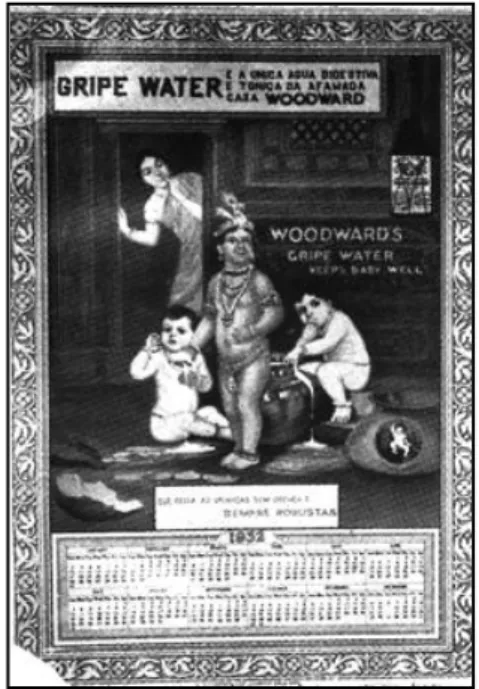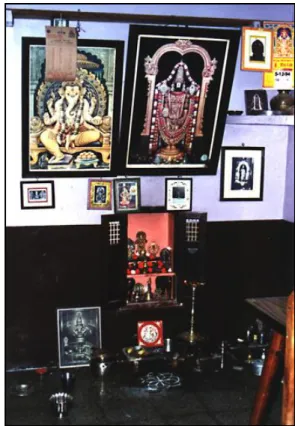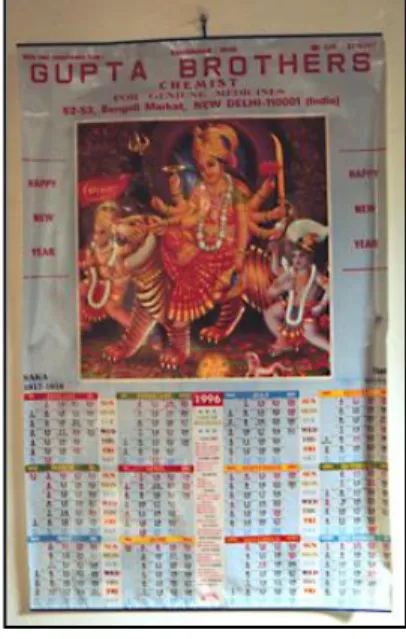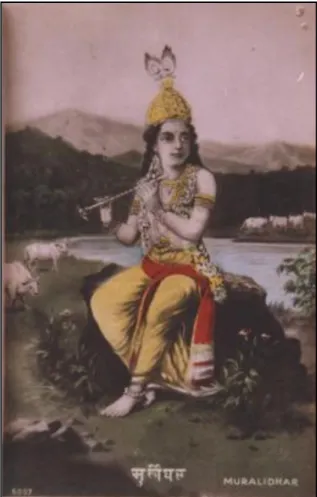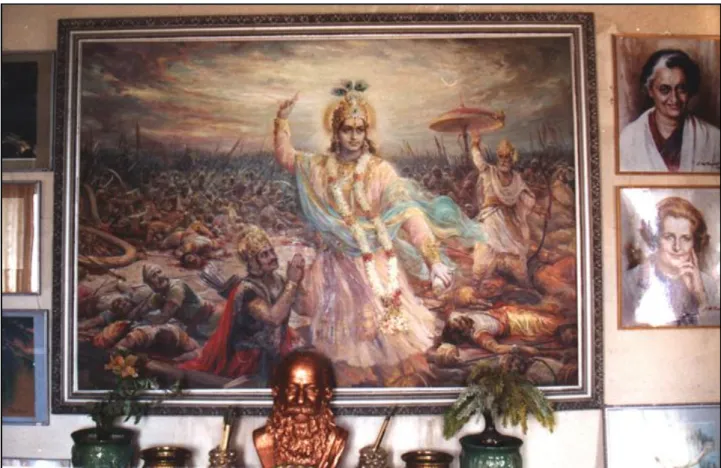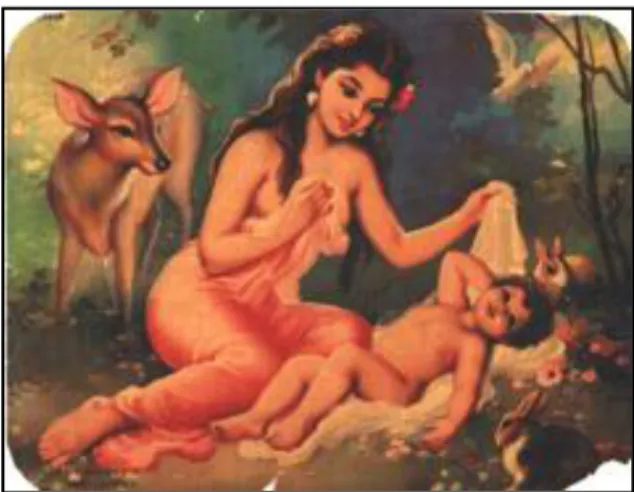Archive, Repertoire or Warehouse?
Producers of Indian Popular Images as Stakeholders in a Virtual Database
by Kajri Jain
South Asian Visual Culture Series, no. 3
edited by Christiane Brosius
(this paper has been edited in collaboration with Sumathi Ramaswamy, Duke University, and Tasveer Ghar: A Digital Network of South Asian Popular
Visual Culture)
Heidelberg, 08. January, 2009
© Kajri Jain
Archive, Repertoire or Warehouse?
Producers of Indian Popular Images as Stakeholders in a Virtual Database
Kajri Jain
‘<the technical structure of the archiving archive also determines the structure of the archivable content even in its very coming into existence and in its relationship to the future. The archivization produces as much as it records the event.’
- Jacques Derrida, Archive Fever p.17
This paper is a short meditation on the nature and scope of an archive of Indian popular images, particularly the images that have been the subject of much of my own research so far: the mass-produced prints known as ‘calendar art’ or ‘bazaar art’ (see Jain 2007). Written in the context of a workshop aiming to conceptualize a scholarly archive of South Asian popular art, it explores what kinds of events might be recorded or traced by such an archive, and what kinds of events it might produce. A good starting point in addressing these questions, to my mind, is a consideration of how calendar art has already been or is being ‘archived’ by people within the popular print industry, for any proposed scholarly archive would be an addition to several existing collections of bazaar prints, which speak to various coexisting – and sometimes competing – frames of value. The raisons d'être of these other collections will exert pressure on any new archive, shaping the ways in which it is used and what it is possible to include in it. These coexisting archives also raise the underlying issue of the ongoing social life of bazaar images and the industry that produces them. How might a scholarly archive relate to that ongoing life – if indeed it
is ongoing? Or, more specifically, given that an archive is not a passive but an active presence, will the productiveness of this presence be an enriching one, or will the scholarly archive’s inherent links with historical thinking, encapsulated in the imperative of preservation, make it a portent and agent of pastness, of demise?
In raising this issue I am drawing on the debates in museum studies around UNESCO’s controversial initiative to include ‘intangible heritage’ as cultural property to be protected and preserved, where ‘intangible heritage’ includes ephemeral forms such as folk culture and popular practices (see Kurin 2004, Brown 2005, Kirshenblatt-Gimblett 2005).1 These debates foreground the problematic nature of the very concept of ‘heritage’, for as the anthropologist Barbara Kirshenblatt-Gimblett (2004) has suggested, its logic is one of ‘metacultural production’, where heritage becomes ‘a mode of cultural production that gives the endangered or outmoded a second life as an exhibition of itself’ (ibid: 56).
Kirshenblatt-Gimblett identifies an inherent paradox in attempting to preserve intangible heritage: as she succinctly puts it, ‘if *heritage+ is truly vital, it does not need safeguarding;
if it is almost dead, safeguarding will not help’ (ibid). At the heart of the problem, of course, is the notion of culture as something that can be frozen at a particular historical moment, without regard to changing social, economic and political conditions. But I want to suggest that we don’t have to see the archive in these oppositional terms, as either a
‘living tradition’ or a petrification – or to use a more South Asian metaphor – as a pickling of culture. Instead, we can reformulate the very idea of what is recorded by archives and museums: rather than seeing ‘through’ the archive as a way of preserving the social life or circulation of an object or corpus, we can approach the archive itself as the trace of a shift in the registers of value these objects inhabit.
In other words, I’m suggesting that the institution of a scholarly archive or museum indexes a fundamental shift in the balance of existing frames of value, of the sort that Walter Benjamin outlined in his account of the way mass reproduction engendered a shift from cult value to exhibition value (Benjamin 1969). To give you an example from the context of Indian popular culture, I think it’s no coincidence that Rajadhyaksha and Willemen’s seminal Encyclopedia of Indian Cinema first appeared in 1994, around the time that the Indian film industry started to undergo a structural reconfiguration in response to economic liberalization (Rajadhyaksha and Willemen 1994). From primarily – but by no means exclusively – domestic circulation, reaching across the class spectrum to the urban and rural poor, popular cinema began primarily addressing a transnational South Asian middle class; film exhibition shifted to multiplexes; and the industry started becoming more professionalized or corporatized (see Rajadhyaksha 2003). Arguably, this shift was also indexed by Bollywood’s own cinematic archiving – through its film narratives – of the
1 I thank Ray Silverman for generously providing me with an invaluable roadmap to this literature.
Bombay underworld that had hitherto been integral to film funding (see Mazumdar 2007).
In other words, it seems to be axiomatic that as soon as it becomes institutionally possible to bring a process into analytic focus, to address it explicitly, we know that there has been a reconfiguration of power relations; that the real action is now elsewhere. In this light we can reformulate the question of what event the proposed archive might record, to ask what kinds of shifts might be taking place in the calendar industry to make the idea of the institutionalized archive possible?
With this question in mind, I’d quickly like to sketch how the calendar art industry was structured up until the late 1990s and the changes it has undergone since then. This will also help us to make sense of the ways in which people in the industry have or have not sought to maintain their own image collections, which will in turn provide some clues as to the generative possibilities of a new archive.
Calendar art has been produced in India since the second half of the 19th century, initially taking the form of wall posters or ‘framing pictures’, as they’re called in the industry. Around the beginning of the 20th century these images also came to be used on advertisements and annual calendars distributed by businesses to their clients and associates (figs. 1-3).
Figure 1. Advertising calendar produced by the Bradford Dyer’s Association, England, for circulation in India, featuring the Hindu god Ganesh.
(Courtesy Priya Paul.)
Figure 2.Calendar for Woodward’s Gripe Water, MV Dhurandhar, 1932, depicting a well-known episode from the infancy of the god Krishna, where he and his brother Balaram are caught stealing butter.
(Collection of Ambika Dhurandhar.)
Figure 3. Calendar for Sunanda Agarbathi Factory, Mysore, 1964, with an image of Sri Durga Lakshmi.
The majority of bazaar prints have been religious images, and most of these in turn – but by no means all – have been Hindu icons, that are often worshipped in shrines, formal and informal, public and private (figs. 4-5).
The form developed in several centres, and calendar artists continue to be dispersed across the country. However, after offset presses were introduced around the early 1960s the bulk of bazaar prints have been printed in one tiny town in the south Indian state of Tamil Nadu, called Sivakasi. But this centralized production system has remained responsive to consumer demand at the most local level, due to the extensive networks of agents or middlemen used to garner orders and distribute prints and calendars across the subcontinent and beyond.
Calendar agents gather orders from businesses in their region on the basis of ‘files’ or catalogues of designs produced every year by the Sivaskasi printers. These files index the industry’s ingenious economies of scale, consisting of full-colour offset printed designs, which are only economical in runs over a couple of thousand.
However, a section at the top or bottom of the calendar is left blank, and can therefore be overprinted with the dates and/or a company’s name using letterpresses, which are economical for runs of a couple of hundred (figs.
6-8).
Figure 4. Prayer space outside the kitchen of a Brahmin household, Sivakasi, 1994.
Figure 5. 1996 calendar advertising candidates for the Bharatiya Janata Party, neighbourhood shrine, Varanasi, 1995. Ganesh is seated on a lotus, which is the BJP’s election symbol.
This customization means that calendars have been an affordable means of publicity for businesses ranging in scale from large corporations, through smaller-scale manufacturers and traders, to the neighborhood chemist, jeweler or tailor. It also means that clients can select a range of designs according to their specific constituencies, so for instance a Madhya Pradesh footwear dealer ordered one Muslim and one Hindu ‘pose’ for his 1995 calendars.
Mediating between the agents and the Sivakasi-based printers are the calendar publishers or manufacturers, mainly based in the larger regional centers. While publishers often run their own local presses, they mostly use the agents’ orders as a basis for bulk- buying calendars from Sivakasi, and then organize the customized overprinting for the agents’ clients. Most publishers also stock framing pictures, again mostly printed in Sivakasi, which they supply to smaller-scale retailers and peddlers. So both the publishers in the larger cities and the Sivakasi printers approach artists to produce designs.
One of the most salient features of the industry for our purposes is the annual cycle characterizing the market for calendars and, to a lesser extent, for the framing pictures.
Every year businesses demand ‘new’ images, within the same fairly circumscribed set of subjects, of which most are religious icons conforming to tightly specified iconographies with conventionalized regional variations. And similarly, framing pictures are often bought or replaced on particular annual festivals such as Diwali or Vishwakarma Jayanti.
Here the novelty-within-sameness that characterizes the mass-cultural commodity ties in with religious demands, for the association of novelty with plenitude and renewal reinscribes the calendar as an auspicious gift in a vernacular business ethos where religion and commerce are deeply intertwined. Within this moral economy, the value of novelty
Figure 6. Poster for Khurana traders, Delhi.
Figure 7. Landscape calendar distributed by a Hindu jewellery store, on display in a Muslim barbershop, Landour Bazaar, Mussoorie, 2000.
Figure 8. Calendar for Gupta Brothers Chemists, New Delhi, 1996.
does not lie in originality, but in renewal or replenishment – the return of the same. This has direct bearing on the calendar industry’s regime of copyright, or rather on the difficulty of implementing such a regime.
There is broad agreement in the industry that copyright for an image resides with the publisher: once an artwork has been handed over a publisher and the artist paid for their services, the publisher owns all reproduction rights. However, there is also broad agreement that copyright doesn’t really exist in the industry, and that everyone copies to a greater or lesser extent, so no-one can afford to accuse anyone else of plagiarism. So artists are ranged along a gradient from the outright ‘hacks’ to the more ‘original’, and compensated accordingly. At the lowest end the industry now dispenses with artists altogether, plundering its own archive to digitally create infinite permutations and combinations of foregrounds and backgrounds. This practice has a long genealogy, for photography has been an integral part of the image-making process from the earliest days of the industry (figs. 9-10).
Figure 9. 2001 calendar for Esdee Paints Ltd, Mumbai, featuring a recycled painting of Lakshmi superimposed on a photographic background. Such recycling and interchanging of foregrounds and backgrounds, enabled by the adoption of computer technology, was prevalent by the late 1990s, indexing the reluctance of calendar printers to invest in new designs.
Figure 10. Photographic Krishna image, early twentieth century, Nathdwara, 1995.
Against this background, then, we can start to make sense of the varying responses I got when I asked people in the industry whether they maintained their own collections of prints or artwork. Most printers and publishers I spoke to in the early 1990s said that they routinely disposed of old stock, including original artwork, simply because it took up useful warehouse space. However many did keep film negatives and even glass plates from an earlier era, for these can be redeployed in various ways. Given the slim profit margins that characterize this industry, it’s hardly surprising that materials are re-used wherever possible - metal plates are recycled, and in several Sivakasi presses earlier lithographic stones have been re-used as steps and pavers. And, as I’ve mentioned, earlier designs are plagiarized to produce new ones. So the archive here is essentially a warehouse, a stock of goods that have market value now or in the future. The proprietor of one Sivakasi press recently informed me that they are digitizing all their commercial paintings; they hope to have a ‘complete archive’ (to use his words) by the end of the year.
The reason for doing so, and I quote from his email, is ‘to re-use them by retouching them on the computer. It’s also a better way to store them and takes less space’. It seems unlikely that he will want to make this archive available in the public domain, or at least not at high resolution. Indeed, when I mentioned the proposed virtual archive, he said he hadn’t realized how much interest there was and that he had ‘better hang onto’ some of the paintings he would otherwise have sold. In other words, then, there seems to be an inverse relationship between the commercial usefulness of an image and its availability to a public archive.
When it comes to the archives of artists, however, things aren’t quite so straightforward. There are certainly artists – and their heirs – who maintain jealously guarded collections of their work, retaining strict control over access and reproduction rights. Rumour has it that the Meerut-based artist Yogendra Rastogi now has a climate- controlled archive of his work; I have yet to substantiate this, as this was not the case when I met him in the early 1990s, but I have visited the house-museums of BG Sharma in Udaipur (see http://bgsharmaart.com/artist.htm) and SM Pandit in Gulbarga, where photography is strictly prohibited. These collections are positioned somewhere between the warehouse and the museumizing archive whose concern is with preservation for prosperity on the one hand, and the legitimizing authority of history on the other. BG Sharma, whose gallery’s flyer uses the word ‘heritage’, says he established it ‘especially for the youth’, and that its ‘300 paintings are on display as a repository of the tradition’.
Both museums showcase the artists’ ‘fine art’ rather than their commercial work: Sharma’s stunning renditions of mythological themes that blend Rajasthani miniature styles with western techniques; or Pandit’s oil paintings of Kali, the battlefield at Kurukshetra, and portraits of Indira Gandhi and Margaret Thatcher (fig. 11).
Here it is important to understand that many calendar artists are deeply invested in the notion of ‘fine art’ and its distinction from commercial art; they understand its discourse and participate in or feel excluded from its aura. Several artists, including Sharma and Pandit, have attended prestigious art schools such as the JJ School of Art in Bombay. So these archives are a means of establishing the artists’ association with the aura of ‘fine’ art, and the social distinction that entails.
This social assertion often ties in with the politics of caste, for while communities engaged in arts and crafts have typically been consigned to the so-called ‚backward‛
castes, a professional career as a commercial artist can enable a great deal of social mobility; Sharma’s museum, for instance, is a three-storey edifice built entirely in marble.
Indeed, in Pandit’s case the museum seemed to be all about social assertion and legitimation, for as far as I could tell no-one actually visited it; the mere fact of its existence (as part of a large, gracious family home) was enough. There is an added dimension to this: Pandit had an official wife and family in Gulbarga, but also a second wife and family in Bombay. The Gulbarga museum is maintained by Pandit’s oldest son, whose agenda is clearly to maintain control over his father’s works and any profits that might flow from them. So he was initially very reluctant to allow me to photograph anything in the museum. However, when I suggested that my documentation might help to strengthen
Figure 11. Krishna on the battlefield at Kurukshetra’, oil painting by SM Pandit. On the right are portraits of Indira Gandhi and Margaret Thatcher, while below it is a bust of the artist. SM Pandit Museum, Gulbarga. (Courtesy KS Pandit, SM Pandit Museum, Gulbarga.)
Pandit’s reputation in the international arena, he relented, and indeed has generously allowed me to use these pictures in my book Gods in the Bazaar. When I was seeking permissions for the book, the most prompt and enthusiastic letters came from artists, who saw this as a means of legitimation, while the most suspicious were the publishers, who wanted to be sure they weren’t losing out on a commercial opportunity (evidently they had no idea just how unprofitable academic publishing can be!). So my sense is that while publishers might not be so forthcoming, many artists might well be willing to become partners in a virtual archive if they were confident it would foreground their contribution to the form and treat them with the respect that they deserve.
Again, this has its limits. BG Sharma, for instance, refused to budge on photography at his gallery, for he has no need for legitimation by academic research. Sharma is in a different league to Pandit, particularly since his work has been taken up by the California- based Mandala Publishing, which produces lavishly illustrated coffee-table Hindu epics and books on Hinduism, popular with Western neo-spiritualists and heritage-hungry non- resident Indians (NRIs). As one Mandala blurb puts it: ‘<the hallmark of his work is its unmistakable aura of deep devotion.’ It may have been a publisher like Mandala who paid the picture publishers SS Brijbasi and Sons 10,000 USD for reproduction rights for images by various artists; here calendar art’s compact between religion and commerce has entered a different kind of global arena.
This escalation of work by calendar artists into a new register of value accompanies a decline in the earlier market for calendars as a means of maintaining social and commercial relations in what historians have termed the ‘bazaar’ economy. For much of the twentieth century calendars circulated as gifts within the domestic and transnational networks of what I have described as a ‚vernacular capitalism‛, characterized by family businesses and informal circuits of credit based on social relations (Jain 2007). As many bazaar-style firms start to operate within a more (though by no means completely) managerial and corporatized post-liberalization business culture, the calendars have been giving way to more expensive or more secular gifts on the one hand and less personalized forms of mass-mediated publicity on the other – notably press and television advertising, which have enjoyed a boom over the last decade or so.
This shift, and the accompanying sense of disappearance, is already marked by an archiving tendency in relation to popular art. Private collections have mushroomed, as have galleries dealing in early bazaar prints and film memorabilia, and there has been a concerted effort by art market operatives such as the auction house Osian’s to bring older popular images into the collector’s market: that is, to imbue them with exhibition value.
As Osian’s chairman and curator Neville Tuli baldly put it, ‚We are trying to give
financial value to a unique art form‛2. Osian’s encompasses an auction house and attendant wealth management services, a publication house and the Centre for Archiving, Research and Documentation (CARD for short): an archive that embodies a nexus between commercial warehousing, historical legitimation and would-be-critical scholarship. In the Osian’s publicity materials ‘art’, with its self-evident value, belongs to the contemporary moment, while the terms ‘history’ and ‘heritage’ are liberally deployed in relation to film memorabilia and bazaar images, distancing these collectible objects from ongoing cultural production.3
But does this anteriorizing narrative, if I can call it that, signal a decline in the uses of popular imagery, and particularly of icons? In her critique of the metacultural operation of
‘heritage’, Barbara Kirshenblatt-Gimblett counterposes this to the ‘repertoire’ as elaborated by the performance theorist Diana Taylor: a form of collection that is not about the kind of value-addition through ‘pickling’ that I have just described, but about ongoing performance, about ‘embodied knowledge and the social relations for its creation, enactment, transmission and reproduction’ (2004: 60). Needless to say, several existing image-collections, particularly those belonging to calendar artists, have served as repertoires, feeding into their practice by providing references for artistic techniques and iconographic prototypes. These archives mostly house works by other artists, as with the collection of the late Ram Waeerkar, the first illustrator of the Amar Chitra Katha mythological comic books, based in Bombay. Waeerkar maintained a series of scrapbooks mostly featuring colour illustrations on mythological themes from annual Diwali (newyear) magazines in Marathi by Bombay artists such as Mulgaonkar and Dalal working in the 1960s and 70s (figs. 12-14), as well as a terrific collection of cartoons from the earlier career of the Shiv Sena leader Bal Thackeray.
Another such ‘repertoire’ is the Sivakasi artist S.
Courtallam’s collection of product labels and stationery cover designs by himself and others, including early lithographs (figs. 15-18), and calendars by his mentor Ram Kumar Sharma.
These sources are on a continuum with reference books, like those used by the Sivakasi artist Ravi, which included a book on airbrush techniques by one Boris Vallejo and an illustrated book called Prehistoric Man which
2 www.newsindia-times.com/2002/03/08/cinema-vintage.html#
3 Thus the titles of the Osian’s exhibition/auction catalogues include India: A Historical Lila (October 2001), A Historical Mela: The ABC of India (March 2002) and A Historical Epic: India in the Making 1757-1950 (August 2002).
Figure 12. Shakuntala-Bharat by RS Mulgaonkar, printed at the Shiv Raj Fine Arts Litho Works, Nagpur.
Ravi used as a visual reference for the mythological period, in a typically postcolonial queering of the opposition between history and myth.
Taking a cue from Ravi, I want to suggest, pace Kirshenblatt-Gimblett, that it isn’t always that easy or that useful to draw a line between ‘real’, living culture and the
‘metaculture’ of heritage. Indeed, Kirshenblatt-Gimblett herself asserts that ‘the possession of heritage< is an instrument of modernization and mark of modernity’ (2004: 61). But her critique doesn’t speak to the disjunctive nature of postcolonial modernities and their appropriations of the notion of heritage. The inscription into history via the production of
‘heritage’ is an integral feature of the kinds of modern identitarian projects to which mass cultural forms in South Asia have been harnessed from the outset. The early prints of Raja Ravi Varma, among others, fuelled and were fuelled by the Independence movement and its inherently paradoxical project of visually incarnating a civilizational heritage in the image of European nations. Or, more recently, the Amar Chitra Katha comics were a conscious attempt to educate Indian children, particularly those from English-medium schools, about Indian mythology, replete with scholarly invocations of textual authority (see Hawley 1995, Pritchett 1995) – in other words as a heritage project, but one that both preserved and remobilized a cultural tradition through a new medium: ‘metaculture’
becoming culture.
Figure 13. Krishna ka Virat Roop (Krisha’s Universal Form), by RS Mulgaonkar, from Ratnaprabha magazine, 1974.
Figure 14. Gopi Vastra Haran (Stealing Clothes from the Gopis) by RS Mulgaonkar, from Ratnaprabha magazine, 1974.
Figures 12-14 from Diwali special colour magazines in the collection of Ram Waeerkar (courtesy Ram Waeerkar).
Similarly, while calendars might be on the wane as lubricants for the vernacular circuits of the bazaar, post-liberalization bazaar images are enjoying a new lease on life in media other than print, fostered by the logics of a post-liberalization millennial capitalism, the global commerce in New Age neo-spiritualism and a translocal politics of cultural identity: in television soaps and children’s animated VCDs; in the increasingly elaborate displays at Durga Puja, Ganapati Utsav and Diwali; in the gigantic religious icons proliferating all over the country; in high-tech religious theme parks like the Swaminarayan cult’s Akshardham temple complexes; and of course on the internet. Just as in an earlier era an SM Pandit painting was used as a model for the Ganesh idol in a temple in Jaipur, virtual images are re-embodied and vice-versa. Thus a PTI report in June 2005 on a new museum dedicated to the god Hanuman, established in Lucknow by a local businessman, described how one unusual exhibit, a two foot statue of Hanuman playing the veena (classical Indian instrument), was inspired by an image downloaded from a
‘spiritual gallery’ on the Internet.4 As with calendar art, these contexts for icon-production speak to a continuing relay between deterritorialized forms of devotion, and ritual contexts under priestly control. While the legitimacy and authority of icons is still underpinned by that of temples and religious institutions, new media and new contexts often work to reformulate existing symbolic structures and bases of authority.5
So the question I want to conclude with is, what kind of repertoire might a digital archive become, and for whom? Many, though not all, of the visual forms I’ve just listed
4 http://www.business-
standard.com/common/storypage.php?hpFlag=Y&chklogin=N&autono=192724&leftnm=lmnu4&lselect=0&le ftindx=4.
5 I have substantiated this somewhat Benjaminian argument elsewhere, in relation to the resignification of muscularity in images of Ram: see Jain 2007.
Figures 15 & 16. Packaging labels from the collection of S. Courtallam. (Courtesy S. Courtallam).
index the cultural nationalism that has replaced economic nationalism in post- liberalization India and the diaspora, one aspect of which is the many-headed monster of Hindutva. But how might an archive be structured so that it articulates better with minoritarian movements, or with uses that don’t feed into a politics of exclusion, absolutism or multicultural ghettoization but into a progressive engagement with and remobilization of icons? I myself have been performatively reinscribing a majoritarian discourse by primarily talking about Hindu icons; but if, for instance, the default classification of images in an archive was by artist it would become evident – for whatever it’s worth – that Hindu images are often produced by Muslim artists and vice-versa.
Here, though, I’d also like to take a step beyond academic pieties and ask how such a repertoire might foster image-making and ritual practices that explore the power of icons to further social justice. How, if at all, might the audio-visual electronic media reincarnate the demotic aural and performative means deployed by saint-poets in the devotional movements of bhakti and sufism? For instance, if governmentality can produce national identity and its constituent elements, or reformulate regional identity; if the Bombay film industry can produce a cult as it did with the goddess Santoshi Maa (see Lutgendorf 2002), could an archive of popular imagery be twinned with an initiative to encourage artists, both fine and commercial, to generate new deities and rituals for our times, or to figure forth more auspicious and egalitarian forms of community and cultural identity, to circulate in the same semi-formal arenas as other kinds of popular culture? In what kind of form would such an initiative provide a non-prescriptive, open-ended, generative space for both theory and artistic practice, the realm not just of the virtuoso but also of the virtual in the Deleuzian sense: that is, not merely the possible (Deleuze 1994)? For if the ritual efficacy of images devolves largely through their circulation as objects or bodies, it is only in the processes of taking form, coming to presence, encountering bodies and finding channels of movement between them that such an intervention can be efficacious.
There is also a role for academics here, in engaging with issues akin to the one Derrida gestures at in relation to psychoanalysis when he says, in Archive Fever, that
‘psychoanalysis would not have been what it was< if electronic mail had existed’ in Freud’s day (Derrida 1996, 17). How does the electronic or virtual realm radically alter our understanding of ritual, community and their performative frames?
I realize that I have asked more questions here than I’ve answered, but, as Derrida suggests, this is in the very nature of the archive. Let me end with another quote from Archive Fever:
‘<the question of the archive is not, I repeat, a question of the past< it is a question of the future< the question of a response, of a promise and of a responsibility for tomorrow. The archive: if we want to know what that will have meant, we will only know in times to come. Perhaps. A spectral messianicity is at work in the concept of the archive
and ties it, like religion, like history, like science itself, to a very singular experience of the promise.’ (Derrida 1996, 36.)
References:
Benjamin, Walter, ‘The Work of Art in the Age of Mechanical Reproduction’, Illuminations, ed. Hannah Arendt, trans. Harry Zohn, New York: Schoken Books, 1969.
Brown, M. F. (2005). "Heritage Trouble: Recent Work on the Protection of Intangible Cultural Property." International Journal of Cultural Property 12: 40-61.
Derrida, Jacques, Archive Fever: A Freudian Impression, trans. Eric Prenowitz, Chicago:
University of Chicago Press, 1996.
Hawley, John Stratton, ‘The Saints Subdued: Domestic Virtue and National Integration in Amar Chitra Katha’, in Babb and Wadley (eds) Media and the Transformation of Religion in South Asia, Philadelphia: University of Pennsylvania Press, 1995.
Jain, Kajri (2007). Gods in the Bazaar: the Economies of Indian Calendar Art, Durham:
Duke University Press.
Kirshenblatt-Gimblett, B. (2004). "Intangible Heritage as Metacultural Production."
Museum International 56 (1-2): 52-65.
Kurin, R. (2004). "Museums and Intangible Heritage: Culture Dead or Alive?" ICOM News 57 (4): 7-9.
Kurin, R. (2004). "Safeguarding Intangible Cultural Heritage in the 2003 UNESCO Convention: A Critical Appraisal." Museum International 56 (1-2): 66-77.
Lutgendorf, Philip (2002), ‘A Superhit Goddess: Jai Santoshi Maa and Caste Hierarchy in Indian Films’, Manushi 131.
Mazumdar, Ranjani (2007), Bombay Cinema: An Archive of the City, Minneapolis: University of Minnesota Press.
Pritchett, Frances W. (1995), ‘The World of Amar Chitra Katha’, in Babb and Wadley (eds), Media and the Transformation of Religion in South Asia, Philadelphia: University of Pennsylvania Press.
Rajadhyaksha, Ashish (2003), ‘The ‘Bollywoodization’ of the Indian cinema: cultural nationalism in a global arena,’ Inter-Asia Cultural Studies, Vol. 4 (1).
Rajadhyaksha, Ashish and Paul Willemen, ed. (1999), Encyclopedia of Indian Cinema (2nd revised edition), London: BFI Publishing.
